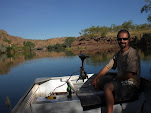Aboriginal Paintings and Injalak Hill
The local arts and crafts centre is called Injalak after a nearby hill that has a great many aboriginal paintings and also offers a terrific view over Gunbalanya and the floodplain. The art centre runs guided tours up the hill on Saturday mornings and I did the tour last weekend (15/11/08).
.JPG)
You drive out to the base of the hill which you climb on foot. The path is a little steep and rocky but anyone who is not badly out of shape or invalid should make the climb. It’s also very hot and exposed so if you’re not used to the territory heat you really need to make sure you take a good supply of water with you. The tour takes about 2 – 2½ hours all up.
The first thing you see on the way up is a view of Arrguluk, which is another of the hills surrounding Gunbalanya. There are three main hills: Injalak, Arrguluk and Nibabbir. Injalak is the easiest to access and is open to everyone. Nibabbir is also OK to visit but it’s further away and more difficult to access so few people bother. Arrguluk is a different matter. It is where the men’s ceremonies are held and is off limits to women and balanda (non-aboriginal) people. All three hills are associated with a dreaming: Magpie Goose for Arrguluk, Fish for Injalak and Leech for Nibabbir.
.JPG)
.JPG)
.JPG)
.JPG)
.JPG)
.JPG)
.JPG)
From there you proceed to the first lot of paintings. The cover the underside of a large overhang, and were painted over an immense period of time from over 10 000 years ago right up until the late 1960’s. Because Injalak has the fish dreaming most of the pictures are of fish – barramundi and long toms are the most common – but there are also pictures of people, spears, goannas, turtles, woven bags, paperbark food carriers and spirits, called Mimi.
.JPG)
.JPG)
.JPG)
.JPG)
.JPG)
.JPG)
.JPG)
.JPG)
.JPG)
.JPG)
.JPG)
.JPG)
.JPG)
.JPG)
.JPG)
.JPG)
.JPG)
.JPG)
.JPG)
.JPG)
.JPG)
.JPG)
.JPG)
.JPG)
.JPG)
.JPG)
.JPG)
.JPG)
The most striking picture of all shows of the Lightning Man. He is shown squatting with a hammer in each hand resting on his knees and surrounded by a circle that represents both the lightning flash and the sound of thunder.
.JPG)
From the rock painting you move on to an area where the dead are laid out and bones laid to rest. No photos are permitted there but it is a very powerful experience.
Next on the tour is a painting of the creation mother.
.JPG)
The traditional belief in this part of Australia is that the earth mother walked across the land carrying woven bags that held the first man and woman for each of the tribes. As she went she would drop off these bags and create a language and culture for each group. Whilst the language and customs differ amongst the various groups in West Arnhem they all use the same Moiety’s and skin names and they share this belief about the creation mother.
The final stop on the tour is the summit. This offers a spectacular view of the township of Gunbalanya, the lagoon it lies beside and the immense flood plain that surrounds it.
.JPG)
.JPG)
.JPG)
.JPG)
.JPG)
.JPG)
.JPG)
.JPG)

.JPG)
.JPG)
.JPG)
.JPG)



1 Comments:
Dammit, you're making me want to visit. Might have to wait until I get a new bike, though.
Post a Comment
<< Home